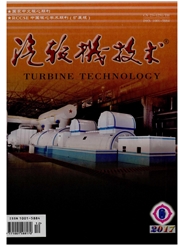

 中文摘要:
中文摘要:
借鉴国内外大型可倾瓦轴承设计技术特点,围绕实际大型可倾瓦轴承设计过程中急需解决的轴承温升、承载力与稳定性的设计难点与耦合问题,采用流固热耦合模型和多场分析技术,对不同瓦块数目变化下可倾瓦轴承的温度场、压力场、最小油膜厚度以及刚度、阻尼等静动特性进行计算分析,结果表明:块数目增加,可倾瓦轴承最大油膜压力和最高温度略有增加,最小有油膜厚度明显减小,导致轴承承载能力明显下降,但轴承刚度、阻尼明显增大,这对提高稳定性有利,实际中可倾瓦轴承瓦块数目的确定应根据设计要求和工况条件进行具体分析。
 英文摘要:
英文摘要:
The tilting pad bearings are widely used in multiple field of high parameter rotor system due to its high stability, adaptive ability for rotor misalignment and load change. Owing to the different application fields and working conditions, the major companies have formed respective technical features in the course of the tilting pad bearing design and manufacturing of high power units, which made the differences of pad (Tilting-pad) number and no unified qualitative and quantitative understanding of the law in this industry. In this paper, the analysis and calculation of the temperature distribution, the pressure field, the minimum oil film thickness and the stiffness and damping of oil film of tilting pad bearing, using the flow solid heat coupling model and multi field analysis techniques, was carried out under the change in the number of tiles. The results show that with the increase of the number of tiles, the maximum oil film pressure and the maximum temperature of tilting pad bearing increased slightly. On the contrary, the minimum oil film thickness decreases significantly, which results in the significant decrease of the bearing capacity and the large increase of the bearing stiffness and damping of the bearing. That is favorable for the improvement of the bearing stability. It can be also conclude that the determination about the pad number of the tilting pad bearing in the practice should be analyzed specifically according to the design requirements and working conditions.
 同期刊论文项目
同期刊论文项目
 同项目期刊论文
同项目期刊论文
 期刊信息
期刊信息
